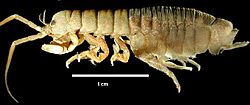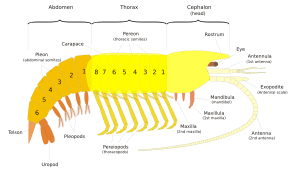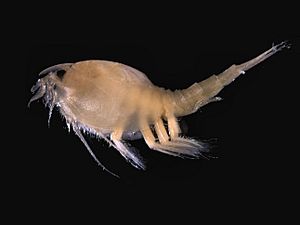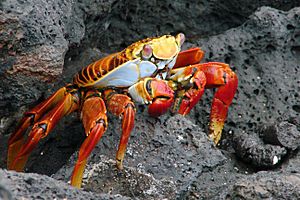Malacostraca facts for kids
Quick facts for kids Malacostraca |
|
|---|---|
 |
|
| Eophreatoicus, a fresh water isopod from Australia. | |
| Scientific classification | |
| Kingdom: | |
| Phylum: | |
| Subphylum: | |
| Class: |
Malacostraca
Latreille, 1802
|
| Subclasses | |
|
Eumalacostraca |
|
The Malacostraca (say: Mal-uh-KOS-truh-kuh) means "soft shell" in Greek. These amazing creatures are the biggest group of crustaceans. They include many animals you might know, like crabs, lobsters, and shrimp.
This group also has mantis shrimp and krill. There are about 22,000 different kinds of malacostracans. This means they make up two-thirds of all crustacean species! The first malacostracans lived a very long time ago, during the Cambrian period.
Scientists are still discussing how to classify crustaceans. Some think Malacostraca is a main group called a class. Others believe it is a smaller group, a subclass.
Contents
Meet the Malacostracans
The Malacostraca group has about 40,000 species. They have a huge variety of body shapes, more than almost any other animal group! Most malacostracans have three main body sections. These are a head with five parts, a middle section (called a thorax) with eight parts, and a tail section (called an abdomen) with six parts. They also have a tail end called a telson.
However, one group, the Leptostraca, is a bit different. They have seven parts in their abdomen, which is an older, more original feature. Malacostracans also have special leg-like parts on their abdomen. This helps tell them apart from most other crustaceans. Each body part usually has a pair of jointed legs. Sometimes, these legs can be lost over time.
How Their Bodies Are Built
The head of a malacostracan has two pairs of antennae. The first pair often splits into two branches. The second pair has outer branches that are often flat, like scales. These are called antennal scales. Their mouthparts include mandibles (jaws) and two pairs of maxillae. Most malacostracans have a pair of compound eyes on stalks. But some have eyes that are not on stalks, or their eyes might be smaller or even missing.
Up to three parts of the thorax can join with the head. This forms a cephalothorax. The legs on these joined parts face forward and become special mouthparts called maxillipeds. A hard shell, called a carapace, might be missing, present, or lost later. It can cover the head, part of the thorax, or even some of the abdomen. The carapace can be different shapes. It might be joined to some thoracic parts or even be in two parts.
Usually, each leg on the thorax has two branches. The inner branch is stronger and used for crawling or grabbing. Each inner branch has seven moving parts. In decapods (like crabs), the claw forms when the last part of the leg presses against an outgrowth of the part before it. In some malacostracans, the outer branch of the leg is lost, so the leg has only one branch.
There is a clear line between the thorax and the abdomen. The abdomen has six or seven parts. The legs on the last part of the abdomen are usually flat. They are called uropods. Together with the telson, they form a "tail fan." This tail fan helps the crustacean quickly escape danger by flexing suddenly. It also helps them steer. In Leptostraca, the parts on the telson are more like spines.
Inside a Malacostracan
The digestive system of a malacostracan is straight. The first part of the stomach has two sections. The first section is like a gizzard. It has a "gastric mill" that grinds food. This mill has hard ridges, teeth, and bony parts. Small food pieces then move into the midgut. Here, chemicals break down the food, and nutrients are absorbed.
Like other crustaceans, malacostracans have an open circulatory system. This means their heart pumps blood into a body cavity called the hemocoel. The blood then flows around the organs, giving them oxygen and nutrients. After that, it flows back to the heart. The blood of malacostracans often uses a blue pigment called haemocyanin to carry oxygen.
Their "kidneys" are located near the base of their antennae. They have a brain made of nerve clusters near the antennae. There are also nerve clusters in each body segment. Sensory organs include compound eyes (often on stalks), simple eyes called ocelli, balance organs called statocysts, and sensory bristles. Young malacostracans have a special eye called a naupliar eye. It has four simple eyes that can tell light from dark.
Where Do They Live?
Malacostracans live in many different places. You can find them in the marine (ocean) and freshwater habitats. Some groups, like certain Amphipoda, Isopoda (woodlice), and Decapoda (like some hermit crabs and land crabs), even live on land.
They are very common in all ocean environments. Most malacostracans are scavengers, meaning they eat dead plants and animals. But some, like porcelain crabs, are filter feeders, straining tiny bits of food from the water. Others, like mantis shrimps, are active carnivores, hunting other animals.
Life Cycle of Malacostracans
Most malacostracan species have separate male and female animals. This is called gonochorism. However, a few species are hermaphrodites, meaning they have both male and female parts.
The earliest malacostracans had a free-swimming larval stage called a nauplius. This tiny larva swims around before growing into its adult form.
Images for kids
See also
 In Spanish: Malacostráceos para niños
In Spanish: Malacostráceos para niños








